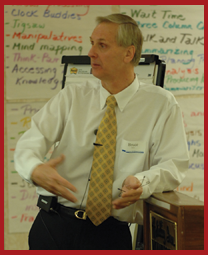
Volume VI Issue V
Share this newsletter on
When Students Don’t Learn

Bruce facilitating a Leading the Learning® workshop
It is a reality as old and timeless as the institution of education. Some students learn quickly and easily while others struggle to master the content. In past decades, schools often separated students into “winners” and “losers.” The winners were the students who excelled, were motivated, and who emerged from their schooling with stellar achievement records. Schools often touted their success by using these exemplary students as examples of the school’s focus on academic excellence. The losers were often given labels such as academically unsuccessful, slow learners, unmotivated, and even handicapped. They were the children who could not keep up or who did not comply with the way schools did business. Their lack of academic achievement was often attributed to a lack of motivation, their unwillingness to work hard, or poor study habits. These problem children were often quickly and easily forgotten.
Although many educators have struggled with the frustrations brought about by today’s accountability requirements, there have been some clear, positive benefits of the emphasis on achievement data and required academic improvement for all students. Students can no longer be shunted off in a corner where they are forgotten or neglected. Schools today fully understand that their mission is to educate all children, and, as a result, they must have practices in place to support students who struggle, need more time to learn, need different learning experiences or need alternative ways to demonstrate their learning. Thus, the focus in schools has shifted from complacency when students do not learn to a need to respond to a very important and necessary question in every school today:
What do we do when students don’t learn?
Range of Possibilities
Responses to this question fall along a continuum of possibilities. At one end of the spectrum are schools that have not formally addressed the question at all and simply maintain the status quo in hopes that “the problem will take care of itself.” Teachers in these schools adhere to the belief that failure should continue to be an option with students suffering the natural consequences. In these environments, there has been little or no schoolwide discussion of the question and teachers are left to their own devices to make instructional decisions. This “burying your head in the sand” approach is flawed on many levels. When the question is not addressed or discussed, little or no change in instruction or assessment may ever occur, and students may succeed by luck or accident but not by design.
In other schools, the importance of the question has been brought to the attention of teachers but individuals are left to determine what steps to take when students do not show adequate academic growth. There is no schoolwide initiative, simply a casual focus on the need to do something. Moving along the continuum are the schools that have addressed the question publicly, have wrestled with possible solutions, and have held numerous problem-solving sessions to surface the practices which have the greatest promise to support student learning. In these environments, it is the responsibility of each teacher to put into place strategies and practices that will lead to greater student learning.
Further down the continuum are schools that have adopted schoolwide initiatives that provide support for any students who do not reach acceptable levels of achievement. These proactive approaches have titles such as “pyramid of interventions,” “failure is not an option,” and “collective self-efficacy.” This type of across-the-board focus of responding to the question has the greatest potential to achieve the necessary improvement in student learning. In these schools, every teacher is on board and follows a specified approach to address the question. They do not leave student achievement and learning to chance or serendipity.
Successful Initiatives
I recently surveyed several principals to learn how they had addressed the question. Most had specific plans in place that were neither haphazard nor random. Their faculties fully understood the importance of having all of their students show academic growth.
Three of the schools had established Professional Learning Communities (PLCs) and have had them in place for three or more years. Teacher collaboration was the hallmark in each of these schools. They also had in place a “Pyramid of Interventions” that they followed when students did not show progress. This approach typically included individual or small group instruction beyond the regular classroom provided by trained professionals. Students remained in these smaller environments until they showed mastery or noted improvement in the necessary skills or knowledge. Another component of some pyramids was a daily schoolwide support program (with such names as “Soar to Success” or “Lunch and Learn”) where students would report to a designated location for remediation or reinforcement. Time for these support programs were carved out of the school day and usually lasted for approximately 30 minutes.
One school tested students and provided intense instruction to any students who were at least two years behind in reading and/or math by assigning these students to teachers who had proven track records for improving student achievement. In the majority of these cases, the school has seen improvement in student learning as measured by standardized test scores.
The principals at two schools believed that many successful practices were already in place. Each used the faculty meeting setting where teachers worked in small groups to discuss the question: What do you do when students don’t learn? Each group had a facilitator and a recorder. The complete compendium of ideas generated by each group was compiled and shared with the entire staff. Strategies included providing one-on-one instruction, re-testing individual students, using pre-assessment data to plan units, and revising teaching methods to meet more student needs. See the document When Students Don’t Learn for an extensive list of strategies and directions for orchestrating such a faculty discussion.
Using the results of a faculty survey, one school found that the teachers understood the importance of differentiating instruction and were willing to provide multiple pathways to learning. The problem was that they did not all have adequate repertoires from which to choose and did not know how to appropriately select from their repertoires to meet the needs of their students. Differentiation of instruction became the school’s professional development focus throughout the next year. This job-embedded professional development included demonstrations of recommended teaching strategies by special education teachers, resource teachers, and instructional coaches. It led to widespread teacher use of carefully selected scaffolding strategies as well as the sharing of successful practices teacher-to-teacher.
True Professionals
In summary, schools that see their mission as educating all children fully accept their responsibility to do as much as possible to ensure that every student learns and succeeds. As professionals, they are unwilling to ignore failure, apathy, or passivity on the part of their students. In these schools, teachers and administrators talk openly about their challenges, resist the temptation to give up on selected students, and use assessment data to determine what next steps they must follow. They use their precious time to seek support and ideas from their colleagues and keep open minds about potential solutions to problems. They do not resort to finger pointing or finding blame when they encounter adversity, especially when students are not successful in showing academic growth. They understand that true professionals often struggle to find answers but they persevere in their quest to find answers to challenging questions. As Rick DuFour says, “Don’t tell me you believe that all kids can learn – tell me what you’re doing about the kids who aren’t learning.”
Permission is granted for reprinting and distribution of this newsletter for non-commercial use only. Please include the following citation on all copies:
Oliver, Bruce. “When Students Don’t Learn.” Just for the ASKing! May 2009. Reproduced with permission of Just ASK Publications & Professional Development (Just ASK). © 2009 Just ASK. All rights reserved. Available at www.justaskpublications.com.



